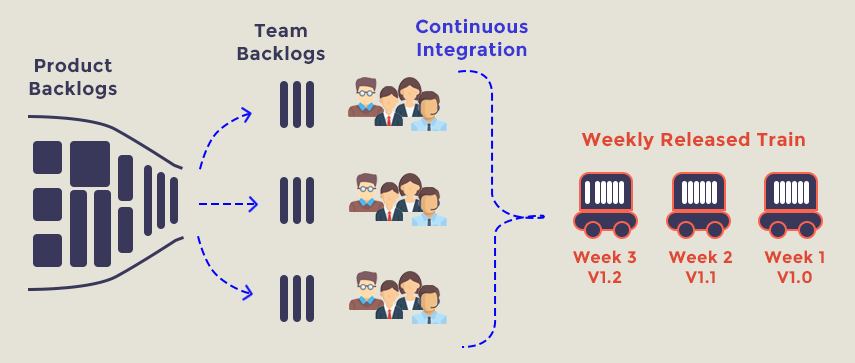
Jerry Rajamoney
He is one of the top 5 in the Agile community to have achieved the dual credential of Professional ... Read more
![]() Get Your AI-Enabled Scrum Master Certification for Just ₹1,500 (Save 85%)!
Get Your AI-Enabled Scrum Master Certification for Just ₹1,500 (Save 85%)!
Scrum.Org
SAFe®
ICAgile
Scrum Alliance
Technical Agility
Kanban
Business Analysis
Project Management
AI-Enabled
Agilemania Academy
Scrum.Org
SAFe®
ICAgile
Scrum Alliance
Technical Agility
Kanban
Business Analysis
Project Management
AI-Enabled

Jerry Rajamoney
He is one of the top 5 in the Agile community to have achieved the dual credential of Professional ... Read more

Yes, Yes, Yes. This is an awesome case for introducing the XXXX Scaled Model in our organization claimed the Program director for agile transformation.
Really?? It’s me asking with curiosity in my voice (can be called “Sarcasm” too?)
“What do you mean? Is this not the perfect case for us to introduce the XXXX Scaled Model as part of our transformation journey?” Asked the program director. Pause….
A few weeks back….
Let’s rewind a few weeks back to see why the program director was so excited.
As the Agile transformation program head and also the Senior Director by designation, my reporting boss is excited about anything and everything about Agile. He is heading the Agile transformation program for the past 9 months and he is happy with the way things are going.
As a part of the New Year strategy, the H.O. advised him to do the next wave of agile transformation (better to call Agile Wave 2.0). As a part of the new wave 2.0 one of the proposals is to introduce the XXXX Scaled Model across the organization.
The program director was looking for enough cases to support his pitch to introduce the XXXX Scaled Model. To his luck, the following feedback from multiple scrum teams popped up

During his H.O. visit, he happened to meet some “Agile Experts” who sold the idea of how using XXXX Scaled Model solved the above-said issues. So now the program director is fully convinced to push the XXXX Scaled Model across an organization.
Pause…..
Fast forward to now...
“Are you sure using the XXXX Scaled Model helps to fix these issues?” It’s me asking the program director.
“Why do you think this will not solve our problem?” Asked back the program director.
“Well, can we NOT conclude the solution from solution space but rather move back to the problem space to see what the problem is?” I asked him back.
Being a big believer in the quote “Problems cannot be solved with the same mindset that created them” my boss agreed to look at beyond just pushing the teams to use the XXXX Scaled Model.
In the next 2 weeks, we figured out some of the other deeper issues that caused the above problem. Some of the critical ones are:
When we met again to review the root cause we figured out we don’t need to use XXXX Scaled Model to fix these issues. We need more alignment and prioritization across the organization at the leadership level.
The next 3 months are really tough as we introduced our own new way of release planning and other related support changes. We got a lot of push to use the XXXX Scaled Model as it was more “fashionable” and also fix the same issues in a more prescriptive way.
No! We are not going to bring the white elephant (XXXX Scaled Model) as part of Wave 2.0.
This is the final bold statement made by the program director after seeing our simple solutions are working much more effectively.
Yes! Sometimes common sense is the most effective framework to use!!!
Disclaimer: This is a work of fiction. Names, characters, businesses, places, events, locales, and incidents are either the products of the author’s imagination or used in a fictitious manner. Any resemblance to actual persons, living or dead, or actual events is purely coincidental.
"Problem space" refers to understanding the core issues within an organization before jumping to solutions. Identifying the problem is crucial for selecting the right approach to resolution.
Successful scaling requires alignment on goals, proper prioritization, clear communication, and strong leadership support, rather than relying solely on a predefined model.
Leadership must facilitate alignment and prioritization across departments to ensure that Agile transformation is successful, rather than pushing for tools or models that may not fit.
By focusing on aligning priorities across departments and ensuring clear communication at the leadership level, the organization overcame prioritization challenges.
He is one of the top 5 in the Agile community to have achieved the dual credential of Professional Coach (PCC) & Certified Enterprise Coach (CEC). A software technologist and an SME in Agile Software Development with 20+ years of experience, Jerry is passionate about building hyper-productive teams which help organizations in their quest for Agility and Digital Transformation in today’s VUCA world.
WhatsApp Us

We will get back to you soon!
For a detailed enquiry, please write to us at connect@agilemania.com



